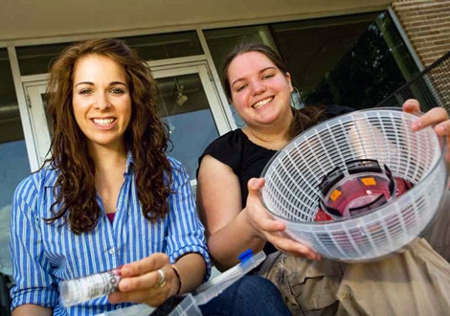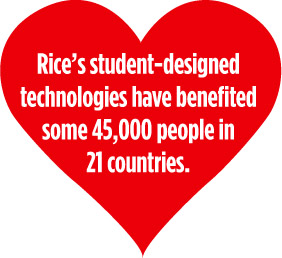Feature: Low Cost, High Impact

Student teams devise health technologies for $2-a-day populations. (From the October 2011 Teaching article by Tom Grose.)
In many poor, rural areas of the world, scourges like malaria, HIV/AIDS, and malnutrition are endemic. Blood tests for anemia are a quick way to diagnose them, but it can take days to get results back from hospitals many miles away. Last year, a multidisciplinary team of Rice University undergraduates devised a clever solution: It’s a centrifuge fashioned from a common salad spinner. In 10 minutes, it separates blood cells from plasma, whereupon a gauge measures the ratio of red cells to total volume and reveals whether the patient has anemia. The device costs about $30 and requires no electricity.
The challenge to develop a cheap, nonelectric device to diagnose anemia was one of several projects given to teams in Appropriate Designs for Global Health, an introductory, project-based design course offered as part of a minor in global health technologies in Rice’s Beyond Traditional Borders (BTB) program.
The Rice program is one of a growing number of “humanitarian engineering” initiatives — some new, others long established — at engineering schools across the country that require students to work in multidisciplinary teams and design, build, and test low-cost, high-tech solutions to public health problems in developing nations. While Rice students focus on health and medical technologies, other programs — including those at the University of Massachusetts, Duke University, Arizona State University, and the Colorado School of Mines — grapple with a host of environmental problems, including a lack of clean water and air pollution, that clearly have a strong public health connection.
“ It’s a wonderful educational experience for our students, but it also gets appropriate technologies to people who need them,” says Lauren Vestewig, executive director of Rice 360º: Institute for Global Health Technologies, which runs the BTB program. “It’s a win-win situation.”
It’s a wonderful educational experience for our students, but it also gets appropriate technologies to people who need them,” says Lauren Vestewig, executive director of Rice 360º: Institute for Global Health Technologies, which runs the BTB program. “It’s a win-win situation.”
Public health problems abound in the world’s poorest regions. Forty percent of humans don’t have access to clean water, 50 percent have no means to treat wastewater, and 20 percent live without electricity. And because half the world’s population lives on less than $2 a day, solutions need to be inexpensive, scalable, and sustainable. They also have to be culturally appropriate for the end-users. What these countries don’t need are technologies that are “Western hand-me-downs,” notes the website for Stanford University’s graduate course Entrepreneurial Design for Extreme Affordability (EDEA).
The courses and programs were largely created to meet student demand. “Students are the primary drivers,” says Thomas Colledge, an assistant professor of engineering design at Pennsylvania State University and codirector of the school’s Humanitarian Engineering and Social Entrepreneurship (HESE) program. Steven Skerlos, an associate professor of mechanical engineering at the University of Michigan, and the faculty adviser to its BLUElab program, agrees. “It’s coming from the students; it’s definitely push, not pull.”
Many of the courses tend to be open to all students, not just engineering majors. Around 10 percent of Rice’s students have taken one of the BTB courses, and the introductory course accepts students of all grade levels. Besides the anemia test, Rice students have developed the Doseright, an inexpensive plastic clip that’s clamped onto an oral syringe and stops the syringe’s plunger once the correct dose of medicine has been delivered, and a Lab-in-a-Backpack stuffed with diagnostic devices and a rechargeable power source. Overall, Rice student-designed technologies have benefited roughly 45,000 people in 21 countries.
Central to Penn State’s 300-student, 10-college HESE program, begun 13 years ago, are two linked courses: the two-credit Projects in Community Service Engineering design course and a one-credit seminar, Design for the Developing Community. The design course requires student teams to design and build a low-cost, high-tech solution to a problem common to the developing world. While only 80 students are enrolled in the design course at any one time, the other 220 students work on parts of projects in another of the technical writing or design courses.
 One highly successful HESE project is a telemedicine system called Mashavu, which uses cellphone technology bundled into kiosks to send the medical histories of individuals in rural villages to physicians in cities that are often hundreds of miles away. The kiosks operate on gas, wind, solar, or microhydro power sources and contain low-cost biosensors.
One highly successful HESE project is a telemedicine system called Mashavu, which uses cellphone technology bundled into kiosks to send the medical histories of individuals in rural villages to physicians in cities that are often hundreds of miles away. The kiosks operate on gas, wind, solar, or microhydro power sources and contain low-cost biosensors.
Stanford’s EDEA course is for graduate students only. One of its high-profile inventions is an incubator for premature babies — who are at risk for hypothermia — that’s essentially a tiny sleeping bag. The key technology is a packet filled with a wax substance. It’s placed in boiling water to melt the wax, which then radiates a steady temperature for four hours. The preemie is slipped inside the sleeping pouch, and the reusable packet of wax is placed in a pocket on the back of the sleeping bag, where it keeps the baby safely warm. It costs only $25 — a staggering savings compared with the $25,000 it costs for a Western-style incubator. General Electric recently ordered 10,000 of them to distribute around India and Nepal.
Typically, courses at the undergraduate level give students plenty of technical guidance before or as they work on projects. For instance, the first third of the Rice course provides a foundation in the engineering design process and rapid prototyping methods. But the nonengineering aspects of a project can be just as important. During the one-credit seminar course at Penn State, engineering students work with peers from other disciplines. A women’s studies major might, for example, explain that a treadle pump would be considered provocative in some cultures because it causes a woman’s hips to sway. “That interplay is essential among the multidisciplinary teams,” Colledge says.
Unlike most other programs, Michigan’s BLUElab is extracurricular — though students who minor in multidisciplinary design can get course credit for their BLUElab project work. But Skerlos disputes the notion that there’s any sort of division between classroom and extracurricular learning. Projects, regardless of whether they’re part of a class or sponsored by an outside organization, are where students learn to design, build, and test, he argues, and where they also learn how to listen to and work with colleagues, stakeholders, and customers from other disciplines and cultures. And when students have to design, build, and test a product, they’ll also learn if any of their core competencies are inadequate. “You can have high scores on tests, but if you don’t know how to use what you’ve learned, what good is it?” Skerlos asks.
That’s a point that Steve Garguilo, 23, wouldn’t dispute. He’s a 2009 Penn State graduate in information sciences and technology who worked on several HESE projects, including Mashavu. The experience was an eye-opener. It wasn’t until 2008 that Garguilo had ever set foot outside the United States. Yet he now works as an emerging markets analyst for Johnson & Johnson, helping to develop appropriate products — a job that so far has taken him to five continents. Hands-on projects in college helped teach him how to be a “cocreator” on a team and to deal with the glitches that inevitably occur outside the lab. “You can never anticipate what’s going to happen,” Garguilo says. “Once you are in the field you have to roll with the punches.”
Colledge, his former professor, says the goal of HESE and programs like it is nothing less than “to transform engineering . . . I see no reason why students won’t be able to major in humanitarian engineering in the future.” Humanity would certainly benefit.
For more on the life-saving salad-spinner, click here.
Past Prism articles related to this topic include “The Barefoot Engineer” (November, 2009); “New Challenges, Same Education?” (April, 2009); “A Human Touch” (October, 2005); and “A World Class Act” (September, 2004).
Thomas K. Grose is Prism’s chief correspondent, based in London.
Filed under: Special Features
Tags: Clean Water, Disease, Engineers Without Borders, Health, Healthcare, University outreach, Water management








